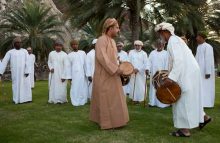 The Sultanate of Oman is a land of breathtaking natural beauty that is linked together with a myriad of mythology and historical events. Oman is the ideal destination for anyone looking for an authentic Arabian experience since it is the oldest independent state in the Arab world. The Sultanate has embraced modernity and progress, while preserving the fundamental elements of its culture and tradition.
The Sultanate of Oman is a land of breathtaking natural beauty that is linked together with a myriad of mythology and historical events. Oman is the ideal destination for anyone looking for an authentic Arabian experience since it is the oldest independent state in the Arab world. The Sultanate has embraced modernity and progress, while preserving the fundamental elements of its culture and tradition.
Oman is the only country in the world whose primary natural resources are rocks from the Earth’s mantle and oceanic crust. Oman’s heritage and history of seafaring, trading, and discovery are ingrained in its culture. Omanis are hospitable to foreign visitors, which is seen in the lavish hospitality shown to them.
Oman is home of one of the world’s biggest underground caverns, the Majlis Al Jinn. Located in the center of Mount Hajar on the northern plateau of Salma, is quite enormous. It is 340 meters long, 128 meters broad, and more than 120 meters high. The Al Hajar Mountains, also known as The Stone Mountains, are one of Oman’s most breathtaking areas, while Jabal Al Akhdar, also called Green Mountain, is a climb away at 2,000 meters above sea level and overlooks a magnificent gorge, surrounded by The Hajar Mountains.
Muttrah Souk is the oldest marketplaces in Oman. It is a center of the country’s trading past for goods coming from the Middle East, Europe, China, and other countries for centuries as they went via the port of Muscat. It remains as bustling as ever, selling traditional fabrics, apparel, jewellery, incense, pipes, pottery, handicrafts, fruits, vegetables, herbs, and spices.
Dhofar, Ẓufār in Arabic, enjoys extraordinary climatic conditions, which effects the southwest coast and hilly terrain. To the northeast of Dhofar is a large desert of stony plains and sand dunes that contribute to the region’s isolation from northern Oman. Salalah, a port city, is at the base of Jabal Al-Qarah, also known as al-Shaba’an Mountain. Deserts and sand dunes make two-thirds of the Omani area. Dhows are traditional Arabian sailboats that have over a 1,000-year history and are commonly seen in the Red Sea.
Misfat Al Abriyeen (an oasis village) is found in Ad Dhakhiliyah Governate’s Al Hamra district. The place derives its name from the Al Abri tribe, who hail from Misfat Al Abriyeen and Al Hamra. Presently, the villagers plant their crops at height of 1,000 meters above sea level on the Oman Mountain. According to an estimate, the construction of the first home in Misfat Al Abriyeen began more than 200 years.
 Tourism Breaking News
Tourism Breaking News